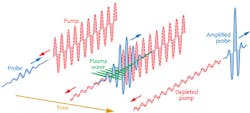NONLINEAR PROCESSES: Raman amplification sets sights on laser fusion
A pulse-amplification process designed for the highest-intensity short-pulse regime looks like it could lend its power to the effort toward laser fusion.
Many techniques attempt to sidestep the most limiting factor to research: damage thresholds. Even chirped-pulse amplification starts damaging its own optics when intensities get near 1012 W/cm2.
One technique to handle these tremendous intensities that is only just seeing its powers put to the test is Raman amplification in plasma. It is a relatively straightforward nonlinear interaction that takes advantage of the fact that plasmas can handle 100,000 times greater intensity than can solid-state optical components.
First proposed by a group at Princeton University (Princeton, NJ) in 1999, the technique relies on counterpropagating beams in a plasma in a process called stimulated Raman backscattering.1 A relatively low-intensity, short-duration “seed pulse” and a much higher-energy “pump” pulse couple through plasma waves (see figure). As they collide, energy is funneled from the pump pulse into the seed pulse, which suffers little temporal broadening and thus gets a significant boost in intensity. The approach has widely been considered for the case of amplifying femtosecond pulses using picosecond pump pulses.
Enlarging the interaction area
A group at the Rutherford Appleton Laboratory’s Central Laser Facility (Didcot, England) had been considering the various effects in these plasma interactions, wondering about the effects of increasing spot sizes—a common approach to reduce intensities in large-scale amplifier systems. “We wanted to properly look at all kinds of instabilities that might come into play if the spot diameter of the laser pulse becomes larger,” says Raoul Trines of the Central Laser Facility. “Most of the earlier research was aimed at getting very high intensities, but not too much was dedicated to larger spot sizes.”
Simulations showed that, even with the instabilities in the plasma brought about by higher interaction areas, the Raman amplification process could bring large pulses into the multi-petawatt regime.2 That work hinged on amplification of compressed pulses of 25–50 fs, and Trines said that many applications benefit from similarly high intensities but with deliberately longer durations—such as inertial-confinement fusion underway at the National Ignition Facility (Livermore, CA). “If you wish to compress a small target for fusion to a sufficiently high temperature and density so the fusion process might start, pulses that have a very high intensity but only last for 25 fs is not enough; it simply takes longer for the target to get compressed,” says Trines.
Other pursuits also benefit from high-temperature compression, such as studies to simulate planetary cores and extreme astrophysical situations. So Trines and his coworkers from the Institute of Plasmas and Nuclear Fusion (Lisbon, Portugal) and the University of St. Andrews (Fife, Scotland) considered amplifying longer pulses.
“The question was what can we do, starting from that work where the compressed pulse was 25 fs in length, to maintain a similar intensity but over a full picosecond—40 times as long,” says Trines.
The answer is to ensure the intensity of the pump is kept low and to keep the ratio between pump- and seed-beam duration at a factor of 1000. To obtain a 2 ps seed beam using a 2 ns pump, the intensity has to be kept below 1011 W/cm2. The result, Trines says, “strongly indicates that it is possible to use the Raman amplification process to start from a nanosecond laser pulse and compress it to a picosecond in duration with an efficiency of up to 50%.”3
The simulations showed efficiencies as high as 60%, but Trines concedes that an actual experiment is unlikely to hit the idealized targets suggested—although the team is eager to try.
D. Jason Palmer | Freelance writer
D. Jason Palmer is a freelance writer based in Florence, Italy.
